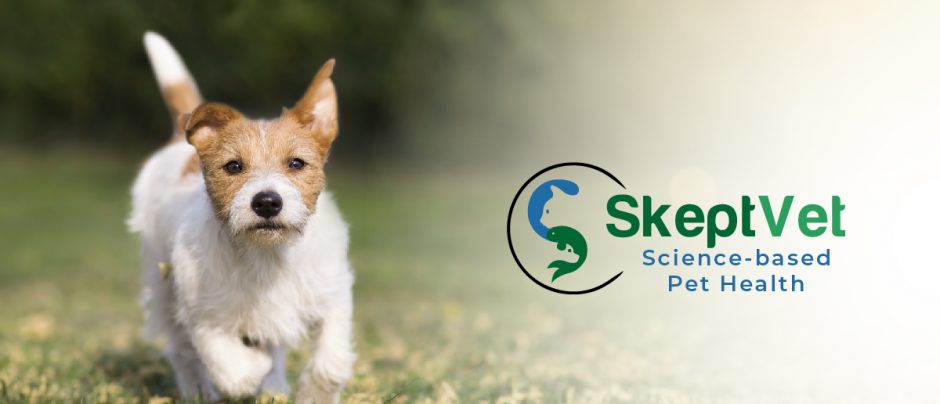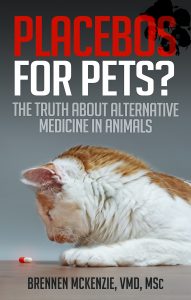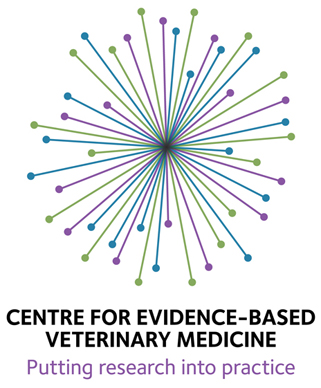Yet another product has entered the market aimed at treating Canine Cognitive Dysfunction Syndrome (CDS). This age-related brain disorder is analogous to dementia in elderly humans, and it involves a number of significant behavioral changes. Affected dogs may get lost in the house, they may have disrupted sleep and restlessness at night, they may show changes in social interactions with people and other animals, and they may experience a breakdown in housetraining. All of these are important symptoms that can adversely affect the quality of life for both pets and owners.
There are no dramatically effective treatments for this disorder, but there are plenty of remedies for sale. The prescription mechanism selegiline has been approved by the FDA for use in this condition, and there is some limited clinical trial evidence to support a benefit, however it is not by any stretch of the imagination a cure. As is typical for incompletely understood diseases with no clearly effective conventional treatment, CDS presents an attractive target for marketers of alternative therapies. And while it is laudable to seek to discover and promote a remedy for an otherwise untreatable disease, unfortunately most of the products targeted at CDS are brought to market well before adequate legitimate research confirms they are safe or effective. Rather than seeking an FDA label approval, which requires significant efforts to prove safety and efficacy, many companies prefer to market their remedies as supplements or nutraceuticals, taking advantage of the lack of effective regulation of such products.
I have previously written about nutraceuticals and CDS (updated here), but the newest product takes a novel approach. Rather than vitamins, antioxidants, or herbs, this product contains as its “active” ingredient apoaequorin, a protein found in certain jellyfish that has long been used in molecular biology research as a tool for monitoring the level of calcium inside of cells. The cleverly named Neutricks (as in “teach an old dog new tricks,” though I can’t help hearing an echo of the unrelated product Neuticals), supposedly reduces the symptoms of CDS by protecting nerve cells in the brain from damage associated with excessive calcium levels.
The company web site references a number of studies showing that injecting apoaequorin into rat brains can protect nerve cells from death when they are later removed from the rat and deprived of oxygen in test tubes (1, 2, 3). This is an interesting finding, but obviously a long way from showing that the product has any clinical benefits in dogs with CDS. Such preliminary animal model research is a necessary first step on the road to proving such a real-world benefit, but by itself it is totally inadequate to justify putting the product into your dog.
One very important step that the maker of Neutricks seems to have skipped (though, as always, I may simply not be able to find all the relevant information, so I am certainly open to being shown additional evidence) is demonstrating that the protein can be absorbed and get to meaningful levels in the brain of dogs when given orally. Proteins are usually destroyed in the stomach (that’s primarily what this organ is for), so many compounds that have significant effects when injected are useless taken orally. A classic example is rattlesnake venom, which can easily kill you when injected by the snake’s fangs into your body, but which is perfectly safe to drink.
The same company also markets apoaequorin as a supplement to treat symptoms of Alzheimer’s and dementia in humans, under the name Prevagen. The company is apparently enrolling and planning a large number of clinical trials studying apoequorin as a treatment for Alzheimer’s disease, other cognitive and memory disorders, autism, multiple sclerosis, Parkinson’s, and apparently any disorder whatsoever involving nerves and calcium. There is apparently only one clinical trial actually completed, and as another blogger has also already pointed out, this pilot trial of 56 participants was uncontrolled, unblinded, and methodologically quite weak. Again, such preliminary studies are appropriate to identify possible side effects or benefits that influence the decision to continue with further research, but they prove nothing and certainly do not justify marketing a product for actual use in patients.
(The company has also issued several press releases discussing “promising interim results” from a human trial involving apoaequorin and memory, but the details of the trial are not yet available, and no peer-reviewed publications of any results have appeared, so it is impossible to evaluate the quality or significance of the results)
As for veterinary research, the company apparently contracted an outside research firm to run a trial of Neutricks in dogs. The study involved 24 laboratory Beagles 9-17 years of age. The subjects were randomly assigned to a placebo group, a low-dose treatment group, and a high-dose treatment group. The subjects were selected from a larger group on the basis of preliminary testing to find animals that reliably performed certain cognitive testing tasks but which “tended to perform at below maximal levels to allow for the possibility of seeing memory enhancement.” The treatments were given and testing done in a properly blinded manner.
The results of pre-treatment testing showed no difference in performance between the three groups. There were three cognitive tests administered: a delayed non-matching to position task (DNMP), a discrimination task, and an attention task. The results were as follows:
1. DNMP Task- No significant difference was seen in performance of the three groups. The report lists some post-hoc manipulation of the data which also show no statistically significant differences but the notorious “trend” often used to imply an effect where the data doesn’t actually show one.
2. Discrimination Task- The low-dose group showed a score and error rate statistically greater than the control and the high-dose group, which did not differ. This is, of course, the opposite of what you would expect if the agent worked since a dose-response relationship, in which the effect increases as the dose increases, is by far the most common result seen with effective medications. It seems most likely that this was simply the inevitable apparently positive result one sometimes sees when testing multiple effect measures in a clinical study. If it is repeatable in multiple studies and by different investigators, then it could turn out to be a real finding.
3. Attention Task- No significant differences between groups were seen in overall performance. The report keeps mentioning results that were “marginally significant” or “approaching significance,” but these are meaningless spin terms. The purpose of significance testing is only to decide, with a pre-determined level of assurance, whether the result could be due to random chance or not. If the usual cutoff of 5% (P=0.05) is used, then a significant result only means that the finding would appear by chance alone only 5 out of 100 trials. It doesn’t mean that the result is due to the effect of treatment or any other specific hypothesis. And when test results don’t reach this 5% level of probability, they are by definition not significant, period.
Some additional post-hoc manipulation of the data yielded a significant difference between the high-dose and the control groups in 1 out of 3 different conditions, with no difference at the other conditions or for the low-dose group.
No adverse events were reported.
Overall, the results of this trial clearly do not justify the clinical use of apoaequorin in treating CDS. The company has not apparently demonstrated even the most basic element in building a case for such use, that the product is absorbed when taken orally and reaches meaningful concentrations in the brain. They have not reported in vitro or laboratory model results that have any direct relevance to the pathology or clinical features of canine cognitive dysfunction. The clinical trial they are using as a marketing tool was conducted on healthy laboratory research Beagles, not owned pets with CDS, and even in this trial there were almost no significant effects seen in subjects getting the product.
Could it work? Sure.
Is there clear evidence it doesn’t work? No.
Is there any significant evidence of risk? No.
And finally, is there any meaningful evidence of beneficial effects? Nope.
So while I certainly would love to see additional, and more relevant testing of apoaequorin and the underlying hypothesis behind its use, at this time it is just another example of selling wishful thinking to people without a lot of better options. I understand why desperate pet owners are willing to grasp at such straws, but I consider it ethically questionable, and certainly scientifically insupportable, to sell them.










My 14-15ish year old Labrador Retriever was diagnosed with CCDS & he had most likely been slowly developing signs of it for the previous 6 months but we had attributed some of his “anxiety” to pain and age. he had been hit by a car prior to coming to me ( at 5ish yrs old) & although he had an FHO to correct the injuries associated with it- he still suffered from severe arthritis and had an old knee injury that had calcified & scar- tissue but we chose not to do surgery for him at the time of discovery. I had used Cold Laser Therapy & Acupuncture to address the pain ( as well as using a Glucosamine/MSM/Chondroitin product for years & copious amounts of Fish oil) and was trying to avoid using an NSAID on a regular basis because I knew it would eventually kill his liver/kidneys but at that time, we had begun to put him on a small dosage of Vetprofin to control the pain . WE had additionally put him on 100 mg of Gabapentin BID to help with the anxiety and the pain- which on some level I believe masked some of the slow loss of his Cognitive Function.
At the time of diagnosis of CCDS my vet mentioned Anipryl as possibility but also stated that most people reported it did not seem to work for their pets. She additionally mentioned the Senilife but also mentioned many people reported mixed reviews of the product. ( I was familiar with this product because I had used it with an another Labrador whom I had agreed to provide hospice care for).
Her recommendation was to continue to provide anti-oxidants, fish oils, and monitor it but that there was not much that could be done.
I owned a natural pet food store and a carried products from a company called Ark Naturals who had recently released a new line of products aimed at Senior Care ( the line is called Gray Muzzle). They had a product called Brain’s Best Friend that contained Fish oil ( omega-3) Acetyl-Lcarnitine, resveratrol, L-theanine, phosphatidylserine, Pyridoxine hydrochloride, & gingko biloboa.
I do feel that it did manage to slow down the progression of the disease and he lived for another 14 or so months.
I put him down in Sept of 2016 because he had Urethral Cancer; however, because of the CCDS, he was not showing any of the signs associated with it other than he a had all of a sudden begun to have very severe the chronic UTIs.
I wish I had known about this product at the time of his diagnosis; however, I am not sure it would have changed anything with the progression of the CCDS.